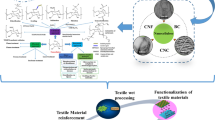Abstract
Stickies deriving from the recycled paper had multiple deleterious effects on the paper chemicals, machine run-nability and paper equality. The aim of this study was to synthesize citosan composite microspheres and remove stickies in the recycled paper by microspheres. Citosan-montmorillonite and chitosan-ferroferric oxide composite microspheres were prepared by emulsion cross-linking method. The surface morphology of microparticels was analyzed by Digital microscope (DM) and Scanning electron microscope (SEM). The removal effects of composite microspheres and talc on stickies were compared. It was found that CS-MMT microspheres had excellent thermal stability than chitosan microspheres and CS-Fe3O4 microspheres. The zeta potential of stock increased with the addition of talc,CS-MMT or CS-Fe3O4. Comparing with the plate talc, CS-MMT or CS-Fe3O4 microspheres adsorbed more easily the stickies and removed DCS in the recycled paper. Meanwhile, CS-MMT or CS-Fe3O4 had less negative impact on the strength of paper than talc. It contributed that there was a large number of hydroxyl groups on the surface of composite microspheres. CS-Fe3O4 had magnetic characteristics and the ability of removing Dissolved and Colloidal Substances (DCS) in white water were superior to CS-MMT.







Similar content being viewed by others
References
Hubbe MA, Rojas OJ, Venditti RA (2006) Control of tacky deposits on paper machines - A review. Nordic Pulp Paper Res J 21:154–171. https://doi.org/10.3183/npprj-2006-21-02-p154-171
Bai YY, Lei YH, Shen XJ, Luo J, Yao CL, Sun RC (2017) A facile sodium alginate-based approach to improve the mechanical properties of recycled fibers. Carbohydr Polym 174:610–616. https://doi.org/10.1016/j.carbpol.2017.06.091
Deng XY, Chen XQ, Li Y (2013) Shen W.H.:interaction between Nano TiO2 and simulacra of dissolved and colloidal substances in the process water of a paper machine. Bioresources 8:3609–3619. https://doi.org/10.15376/biores.8.3.3609-3619
Wang SH (2017) Jing Y.:study on the barrier properties of glycerol to chitosan coating layer. Mater Lett 209:345–348. https://doi.org/10.1016/j.matlet.2017.08.040
Kar S, Kaur T, Thirugnanam A (2016) Microwave-assisted synthesis of porous chitosan modified montmorillonite–hydroxyapatite composite scaffolds. Int J Biol Macromol 82:628–636. https://doi.org/10.1016/j.ijbiomac.2015.10.060
Banik N, Remateke A, Maji TK (2014) Carboxymethyl chitosan-montmorillonite nanoparticles for controlled delivery of isoniazid: evaluation of the effect of the glutaraldehyde and montmorillonite. Polym Adv Technol 25:1580–1589. https://doi.org/10.1002/pat.3406
Bruna RS, Fabiana BB, Tamires SP, Claudinei FS, Roselena F (2015) Chitosan Montmorillonite microspheres:a sustainable fertilizer delivery system. Carbohydr Polym 127:340–346. https://doi.org/10.1016/j.carbpol.2015.03.064
Teng SH, Liang MH, Wang P, Yuo Y (2016) Biomimetic composite microspheres of collagen/chitosan/nano-hydroxyapatite: In-situ synthesis and characterization. Mater Sci Eng C 58:610–613. https://doi.org/10.1016/j.msec.2015.09.021
Yu ZZ, Dang QF, Liu CS, Cha DS, Zhang HF, Zhu WJ, Zhang QQ (2017) Fan B.:preparation and characterization of poly(maleic acid)-grafted cross-linked chitosan microspheres for cd(II) adsorption. Carbohydr Polym 172:28–39. https://doi.org/10.1016/j.carbpol.2017.05.039
Hamid E, Rachid B, El M.E, Mosto B, Abdelkrim EK (2012) Chitosan montmorillonite bio-based aerogel hybrid microspheres. Microporous Mesoporous Mater 152:208–213. https://doi.org/10.1016/j.micromeso.2011.11.032
Wang SH, Jing Y (2016) Effects of a Chitosan Coating Layer on the Surface Properties and Barrier Properties of Kraft Pape. Bioresources 11:1868–1881. https://doi.org/10.15376/biores.11.1.1868-1881
Luo JW, Han GH, Xie MJ, Cai ZR, Wang XY (2015) Quaternized chitosan montmorillonite nanocomposite resin and its adsorption behavior. Iran Polym J 24:531–539. https://doi.org/10.1007/s13726-015-0343-2
Tong J, Chen LG (2013) Review:preparation and application of magnetic chitosan derivatives in separation processes. Anal Lett 46:2635–2656. https://doi.org/10.1080/00032719.2013.807815
Ma W, Dai JD, Dai XH, Yan YS (2014) Preparation and Characterization of Chitosan/Kaolin/Fe3O4 Magnetic Microspheres and Their Application for the Removal of Ciprofloxacin. Adsorpt Sci Technol 32:775–790. https://doi.org/10.1260/0263-6174.32.10.775
Chen DM, Li W, Wu YR, Zhu Q, Lu ZJ, Du GX (2013) Preparation and characterization of chitosan/montmorillonite magnetic microspheres and its application for the removal of Cr (VI). Chem Eng J 221:8–15. https://doi.org/10.1016/j.cej.2013.01.089
Xiao CW, Liu XJ, Mao SM, Zhang LJ, Lu J (2017) Sub-micron-sized polyethylenimine-modified polystyrene/Fe3O4/chitosan magnetic composites for the efficient and recyclable adsorption of Cu(II) ions. Appl Surf Sci 394:378–385. https://doi.org/10.1016/pj.asusc.2016.10.116
Lv SH, Zhu LL, Li Y, Jia CM, Sun SY (2017) The Adsorption Capacity of GONs/CMC/Fe3O4 Magnetic Composite Microspheres and applications for Purifying Dye Wastewater. Materials 10:58–60. https://doi.org/10.3390/ma10010058
Hua C, Zhang RH, Bai F, Lu P, Liang XF (2017) Removal of chromium (VI) from aqueous solutions using quaternized chitosan microspheres. Chin J Chem Eng 25:153–158. https://doi.org/10.1016/j.cjche.2016.08.024
AI-Hclw AA, AI-Angary AA, Mahrous GM et al (1998) Preparation and evaluation ofsustained release CROSS—linked chitosan microspheres containing phenobarbitone. Mieroencapsul 15(3):373–382. https://doi.org/10.3109/02652049809006864
Duan B, Zheng X, Xia Z, Fan X, Guo L, Liu J, Wang Y, Ye Q, Zhang L (2015) Highly biocompatible nanofibrous microspheres self-assembled from chitin in NaOH/Urea aqueous solution as cell carriers. Angew.Chem.Int.Ed 54:5152–5156. https://doi.org/10.1002/anie.201412129
Jameela SR, Jayakrishnan A (1995) Glutaraldehyde cross-Iinked chitosan microspheres as n long acting biodegradable drug delivery vehicle:studies on the in vitro release of mitoxantrone and in vivo degradation of microspheres in rat muscle. Biomaterials 16(10):769–775. https://doi.org/10.1016/0142-9612(95)99639
Cui Q, Zhao H, Luo GS, Xu JH (2017) An Efficient Chitosan/Silica Composite Core-Shell Microspheres-Supported Pd Catalyst for Aryl Iodides Sonogashira Coupling Reactions. Ind Eng Chem Res 56:143–152. https://doi.org/10.1021/acs.iecr.6b04077
Monte MC, Sanchez M, Blanco A, Negro C, Tijero J (2012) Improving deposition tester to study adherent deposits in papermaking. Chem Eng Res Design 90:1491–1499. https://doi.org/10.1016/j.cherd.2012.01.012
Huber P, Delagoutte T, Ossard S (2013) The concept of stickies exposure for paper recycling processes. Nordic Pulp Paper Res J 28:82–93. https://doi.org/10.3183/npprj-2013-28-01-p082-093
Ren Y, Abbood HA, He F, Peng H, Huang KH (2013) Magnetic EDTA modified chitosan/SiO2/Fe3O4 adsorbent: Preparation, characterization, and application in heavy metal adsorption. Chem Eng J 226:300–311. https://doi.org/10.1016/j.cej.2013.04.059
Aarne N, Kontturi E, Laine J (2012) Carboxymethyl cellulose on a fiber substrate: the interactions with cationic polyelectrolytes. Cellulose 19:2217–2231. https://doi.org/10.1007/s10570-012-9793-2
Luo XG, Zeng J, Liu SL, Zhang LN (2015) An effective and recyclable adsorbent for the removal of heavy metal ions from aqueous system: magnetic chitosan/cellulose microspheres. Bioresour Technol 194:403–406. https://doi.org/10.1016/j.biortech.2015.07.044
Acknowledgements
Thank support from the National Science Foundation of China (No. 31370583).
Author information
Authors and Affiliations
Corresponding author
Additional information
Publisher’s note
Springer Nature remains neutral with regard to jurisdictional claims in published maps and institutional affiliations.
Rights and permissions
About this article
Cite this article
Geng, Y., Jing, Y., Wang, S. et al. Synthesis of chitosan composite microspheres and their application for the removal of stickies in the recycled paper. J Polym Res 27, 97 (2020). https://doi.org/10.1007/s10965-020-02064-x
Received:
Accepted:
Published:
DOI: https://doi.org/10.1007/s10965-020-02064-x




